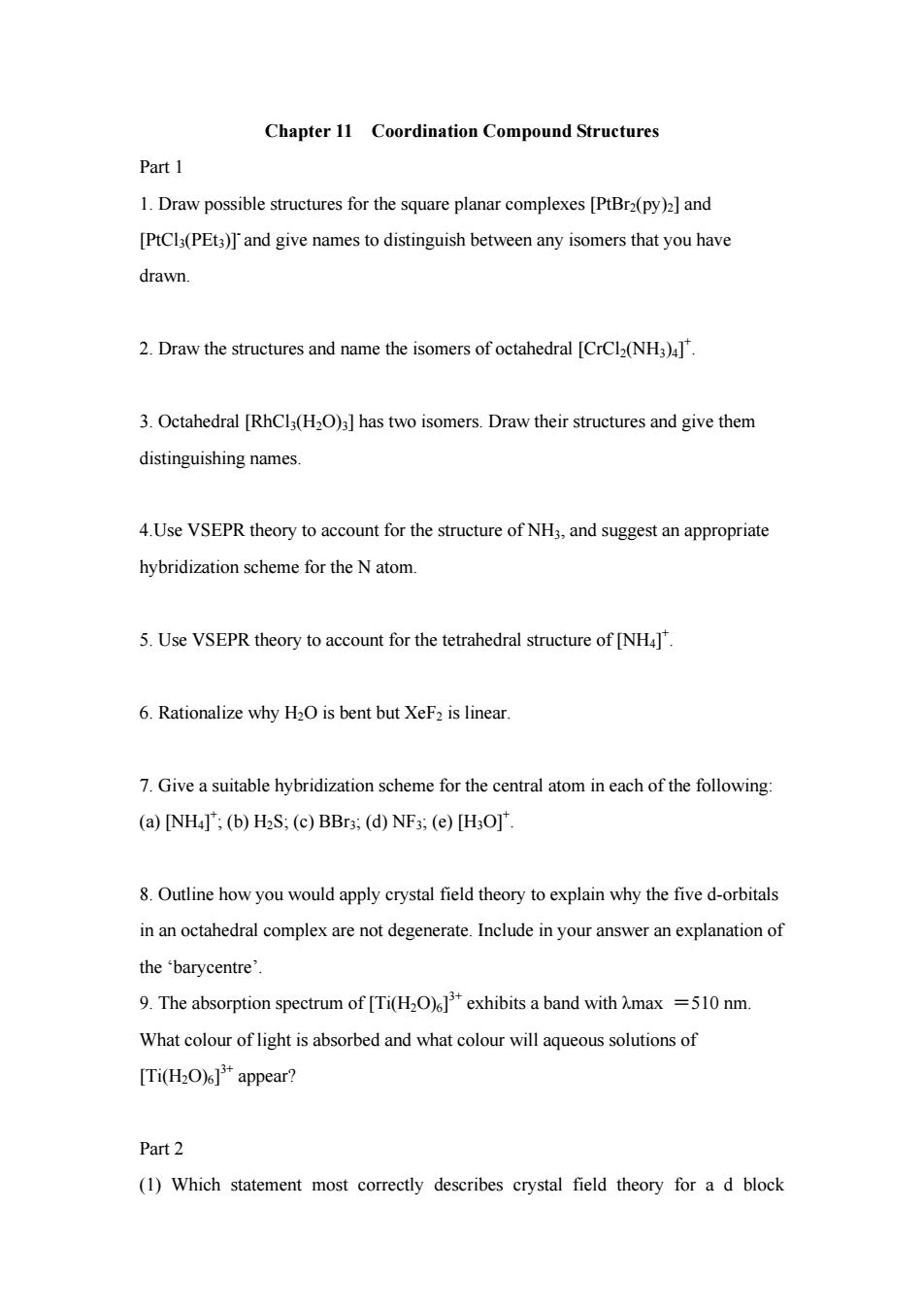
Chapter 11 Coordination Compound Structures Part 1 1.Draw possible structures for the square planar complexes [PtBra(py)2]and [PtCl(PEt)and give names to distinguish between any isomers that you have drawn. 2.Draw the structures and name the isomers of octahedral [CrCl(NH3) 3.Octahedral [RhCl (H2O)]has two isomers.Draw their structures and give them distinguishing names 4.Use VSEPR theory to account for the structure of NH3,and suggest an appropriate hybridization scheme for the N atom. 5.Use VSEPR theory to account for the tetrahedral structure of [NH]" 6.Rationalize why H2O is bent but XeF2 is linear. 7.Give a suitable hybridization scheme for the central atom in each of the following: (a)[NH4]';(b)H2S;(c)BBr3;(d)NF3;(e)[H3O]* 8.Outline how you would apply crystal field theory to explain why the five d-orbitals in an octahedral complex are not degenerate.Include in your answer an explanation of the'barycentre' 9.The absorption spectrum of [Ti(a band with max =510nm What colour of light is absorbed and what colour will aqueous solutions of [Ti(H2O)]appear? Part2 (1)Which statement most correctly describes crystal field theory for a d block
Chapter 11 Coordination Compound Structures Part 1 1. Draw possible structures for the square planar complexes [PtBr2(py)2] and [PtCl3(PEt3)]- and give names to distinguish between any isomers that you have drawn. 2. Draw the structures and name the isomers of octahedral [CrCl2(NH3)4] + . 3. Octahedral [RhCl3(H2O)3] has two isomers. Draw their structures and give them distinguishing names. 4.Use VSEPR theory to account for the structure of NH3, and suggest an appropriate hybridization scheme for the N atom. 5. Use VSEPR theory to account for the tetrahedral structure of [NH4] + . 6. Rationalize why H2O is bent but XeF2 is linear. 7. Give a suitable hybridization scheme for the central atom in each of the following: (a) [NH4] + ; (b) H2S; (c) BBr3; (d) NF3; (e) [H3O]+ . 8. Outline how you would apply crystal field theory to explain why the five d-orbitals in an octahedral complex are not degenerate. Include in your answer an explanation of the ‘barycentre’. 9. The absorption spectrum of [Ti(H2O)6] 3+ exhibits a band with λmax =510 nm. What colour of light is absorbed and what colour will aqueous solutions of [Ti(H2O)6] 3+ appear? Part 2 (1) Which statement most correctly describes crystal field theory for a d block 1
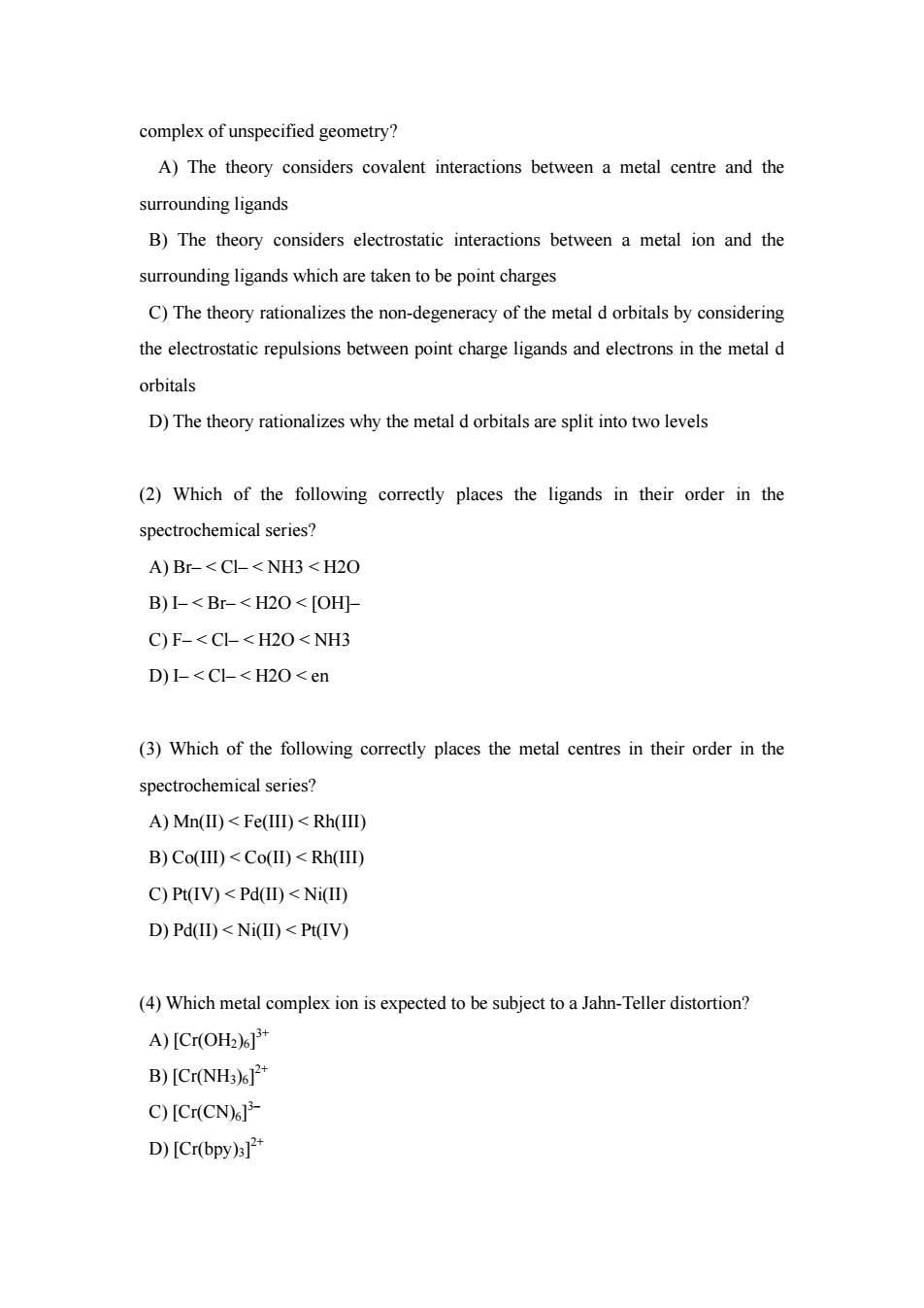
complex of unspecified geometry? A)The theory considers covalent interactions between a metal centre and the surrounding ligands B)The theory considers electrostatic interactions between a metal ion and the surrounding ligands which are taken to be point charges C)The theory rationalizes the non-degeneracy of the metal d orbitals by considering the electrostatic repulsions between point charge ligands and electrons in the metal d orbitals D)The theory rationalizes why the metal d orbitals are split into two levels (2)Which of the following correctly places the ligands in their order in the spectrochemical series? A)Br-<CI-<NH3 <H20 B)I-<Br-<H20<[OH] C)F-<Cl-<H20<NH3 D)-<C-<H20<en (3)Which of the following correctly places the metal centres in their order in the spectrochemical series? A)Mn(II)<Fe(III)<Rh(III) B)Co(III)<Co(ID)<Rh(IID) C)Pt(IV)<Pd(ID)<Ni(II) D)PdW)<Ni⑩<PtIV) (4)Which metal complex ion is expected to be subject to a Jahn-Teller distortion? A)[Cr(OH2)] B)[Cr(NH3)6 C)[Cr(CN)] D)[Cr(bpy)s
complex of unspecified geometry? A) The theory considers covalent interactions between a metal centre and the surrounding ligands B) The theory considers electrostatic interactions between a metal ion and the surrounding ligands which are taken to be point charges C) The theory rationalizes the non-degeneracy of the metal d orbitals by considering the electrostatic repulsions between point charge ligands and electrons in the metal d orbitals D) The theory rationalizes why the metal d orbitals are split into two levels (2) Which of the following correctly places the ligands in their order in the spectrochemical series? A) Br– < Cl– < NH3 < H2O B) I– < Br– < H2O < [OH]– C) F– < Cl– < H2O < NH3 D) I– < Cl– < H2O < en (3) Which of the following correctly places the metal centres in their order in the spectrochemical series? A) Mn(II) < Fe(III) < Rh(III) B) Co(III) < Co(II) < Rh(III) C) Pt(IV) < Pd(II) < Ni(II) D) Pd(II) < Ni(II) < Pt(IV) (4) Which metal complex ion is expected to be subject to a Jahn-Teller distortion? A) [Cr(OH2)6] 3+ B) [Cr(NH3)6] 2+ C) [Cr(CN)6] 3– D) [Cr(bpy)3] 2+ 2
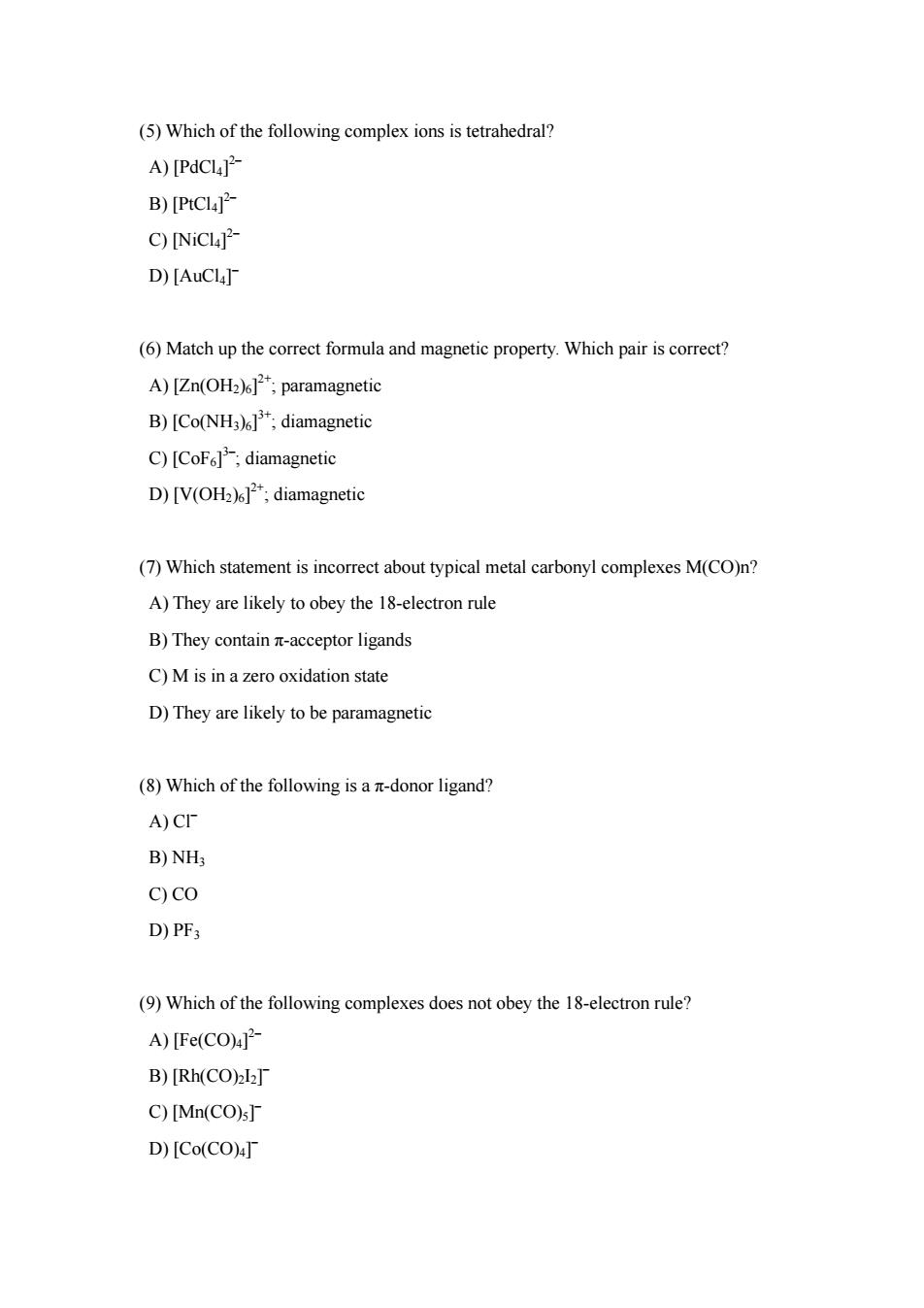
(5)Which of the following complex ions is tetrahedral? A)[PdCL- B)[PtCl4 C)[NiCl- D)[AuCI] (6)Match up the correct formula and magnetic property.Which pair is correct? A)[Zn(OH2);paramagnetic B)[Co(NH3)6];diamagnetic C)[CoF]diamagnetic D)[V(OH2diamagnetic (7)Which statement is incorrect about typical metal carbonyl complexes M(CO)n? A)They are likely to obey the 18-electron rule B)They contain -acceptor ligands C)M is in a zero oxidation state D)They are likely to be paramagnetic (8)Which of the following is a r-donor ligand? A)Cr B)NHs c)co D)PF3 (9)Which of the following complexes does not obey the 18-electron rule? A)[Fe(CO)4 B)[Rh(CO)2I2] C)[Mn(CO)s] D)[Co(CO)4
(5) Which of the following complex ions is tetrahedral? A) [PdCl4] 2– B) [PtCl4] 2– C) [NiCl4] 2– D) [AuCl4] – (6) Match up the correct formula and magnetic property. Which pair is correct? A) [Zn(OH2)6] 2+; paramagnetic B) [Co(NH3)6] 3+; diamagnetic C) [CoF6] 3–; diamagnetic D) [V(OH2)6] 2+; diamagnetic (7) Which statement is incorrect about typical metal carbonyl complexes M(CO)n? A) They are likely to obey the 18-electron rule B) They contain π-acceptor ligands C) M is in a zero oxidation state D) They are likely to be paramagnetic (8) Which of the following is a π-donor ligand? A) Cl– B) NH3 C) CO D) PF3 (9) Which of the following complexes does not obey the 18-electron rule? A) [Fe(CO)4] 2– B) [Rh(CO)2I2] – C) [Mn(CO)5] – D) [Co(CO)4] – 3
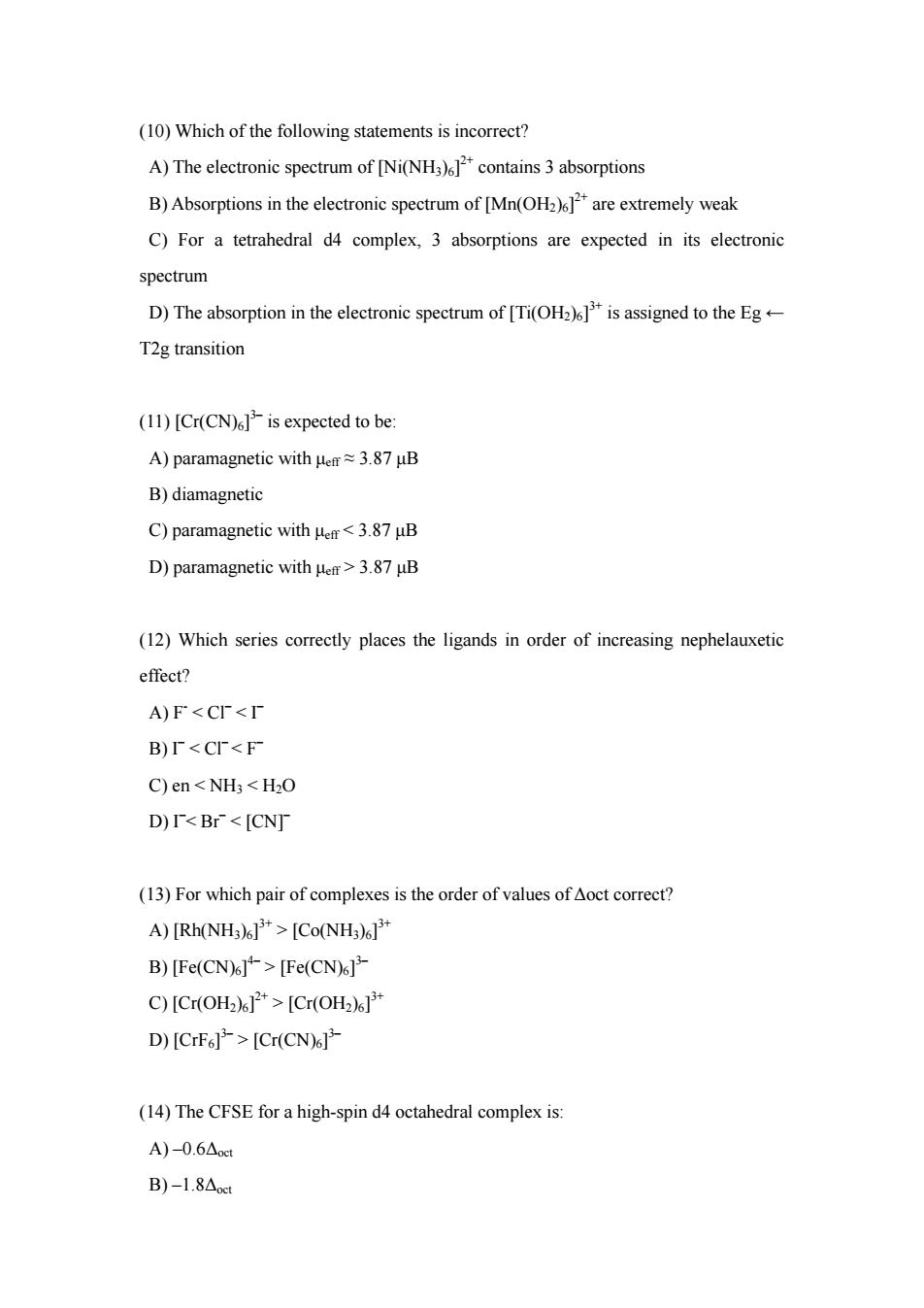
(10)Which of the following statements is incorrect? A)The electronic spectrum of [Ni(NH3)6 contains 3 absorptions B)Absorptions in the electronic spectrum of [Mn(OH2are extremely weak C)For a tetrahedral d4 complex.3 absorptions are expected in its electronic spectrum D)The absorption in the electronic spectrum of [Ti(OH2)]is assigned to the Eg T2g transition (11)[Cr(CN)6]is expected to be: A)paramagnetic with Her3.87 uB B)diamagnetic C)paramagnetic with er3.87 uB (12)Which series correctly places the ligands in order of increasing nephelauxetic effect? A)F[Co(NH3)6P B)[Fe(CN)6>[Fe(CN)] C)[Cr(OH2)6]2+>[Cr(OH2)6J3 D)ICrF6产>[CrCN)%产 (14)The CFSE for a high-spin d4 octahedral complex is: A)-0.6△ B)-1.8Aoct
(10) Which of the following statements is incorrect? A) The electronic spectrum of [Ni(NH3)6] 2+ contains 3 absorptions B) Absorptions in the electronic spectrum of [Mn(OH2)6] 2+ are extremely weak C) For a tetrahedral d4 complex, 3 absorptions are expected in its electronic spectrum D) The absorption in the electronic spectrum of [Ti(OH2)6] 3+ is assigned to the Eg ← T2g transition (11) [Cr(CN)6] 3– is expected to be: A) paramagnetic with μeff ≈ 3.87 μB B) diamagnetic C) paramagnetic with μeff 3.87 μB (12) Which series correctly places the ligands in order of increasing nephelauxetic effect? A) F- [Co(NH3)6] 3+ B) [Fe(CN)6] 4– > [Fe(CN)6] 3– C) [Cr(OH2)6] 2+ > [Cr(OH2)6] 3+ D) [CrF6] 3– > [Cr(CN)6] 3– (14) The CFSE for a high-spin d4 octahedral complex is: A) –0.6Δoct B) –1.8Δoct 4
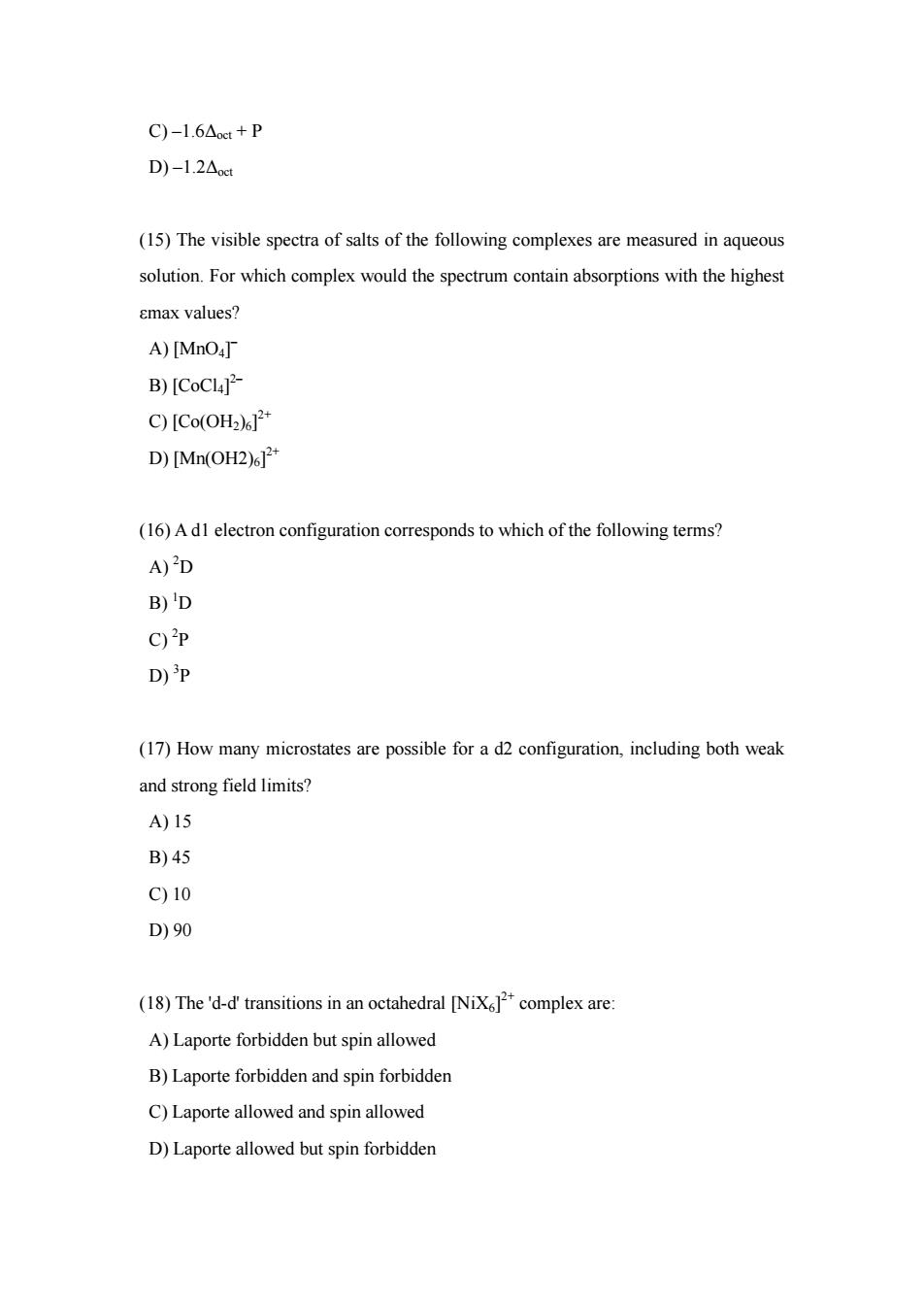
C)-1.6Aoct +P D)-1.2△ (15)The visible spectra of salts of the following complexes are measured in aqueous solution.For which complex would the spectrum contain absorptions with the highest emax values? A)[MnO4 B)[CoCL]2 C)[Co(OH2)62 D)[Mn(OH2)6]2* (16)A dl electron configuration corresponds to which of the following terms? A)D B)'D C)p D)P (17)How many microstates are possible for a d2 configuration,including both weak and strong field limits? A)15 B)45 C)10 D)90 (18)The'd-d'transitions in an octahedral [NiXcomplex are A)Laporte forbidden but spin allowed B)Laporte forbidden and spin forbidden C)Laporte allowed and spin allowed D)Laporte allowed but spin forbidden
C) –1.6Δoct + P D) –1.2Δoct (15) The visible spectra of salts of the following complexes are measured in aqueous solution. For which complex would the spectrum contain absorptions with the highest εmax values? A) [MnO4] – B) [CoCl4] 2– C) [Co(OH2)6] 2+ D) [Mn(OH2)6] 2+ (16) A d1 electron configuration corresponds to which of the following terms? A) 2 D B) 1 D C) 2 P D) 3 P (17) How many microstates are possible for a d2 configuration, including both weak and strong field limits? A) 15 B) 45 C) 10 D) 90 (18) The 'd-d' transitions in an octahedral [NiX6] 2+ complex are: A) Laporte forbidden but spin allowed B) Laporte forbidden and spin forbidden C) Laporte allowed and spin allowed D) Laporte allowed but spin forbidden 5

(19)For which of the following configurations for an octahedral,first row d-block metal ion do you expect there to be an orbital contribution to the magnetic moment? A)2e2 B)t2g C)toge D)tzgeg? (20)Why does the absorption spectrum of aqueous [Ti(OH2)exhibit a broad band with a shoulder? A)The ground state of [Ti(His Jahn-Teller distorted B)The excited state of [Ti(Hundergoes a Jahn-Teller distortion C)[Ti(His ad2ion and therefore there are two absorptions D)[Ti(OH2)6]is partly reduced to [Ti(OH2)in aqueous solution and two absorptions which are close in energy are observed,one for each species Answer: 1.Correct Answer: The theory rationalizes the non-degeneracy of the metal d orbitals by considering the electrostatic repulsions between point charge ligands and electrons in the metal d orbitals 2.Your Answer: <Cr<H2O<en 3.Correct Answer: Mn(ID)<Fe(III)<Rh(III) 4.Correct Answer [Cr(NH3)6P 5.Correct Answer: [NiCl12- 6.Correct Answer [Co(NH3)];diamagnetic
(19) For which of the following configurations for an octahedral, first row d-block metal ion do you expect there to be an orbital contribution to the magnetic moment? A) t2g 2 B) t2g 3 C) t2g 6 eg 1 D) t2g 6 eg 2 (20) Why does the absorption spectrum of aqueous [Ti(OH2)6] 3+ exhibit a broad band with a shoulder? A) The ground state of [Ti(OH2)6] 3+ is Jahn-Teller distorted B) The excited state of [Ti(OH2)6] 3+ undergoes a Jahn-Teller distortion C) [Ti(OH2)6] 3+ is a d2 ion and therefore there are two absorptions D) [Ti(OH2)6] 3+ is partly reduced to [Ti(OH2)6] 2+ in aqueous solution and two absorptions which are close in energy are observed, one for each species Answer: 1.Correct Answer: The theory rationalizes the non-degeneracy of the metal d orbitals by considering the electrostatic repulsions between point charge ligands and electrons in the metal d orbitals 2.Your Answer: I– < Cl– < H2O < en 3.Correct Answer: Mn(II) < Fe(III) < Rh(III) 4.Correct Answer: [Cr(NH3)6] 2+ 5.Correct Answer: [NiCl4] 2– 6.Correct Answer: [Co(NH3)6] 3+; diamagnetic 6
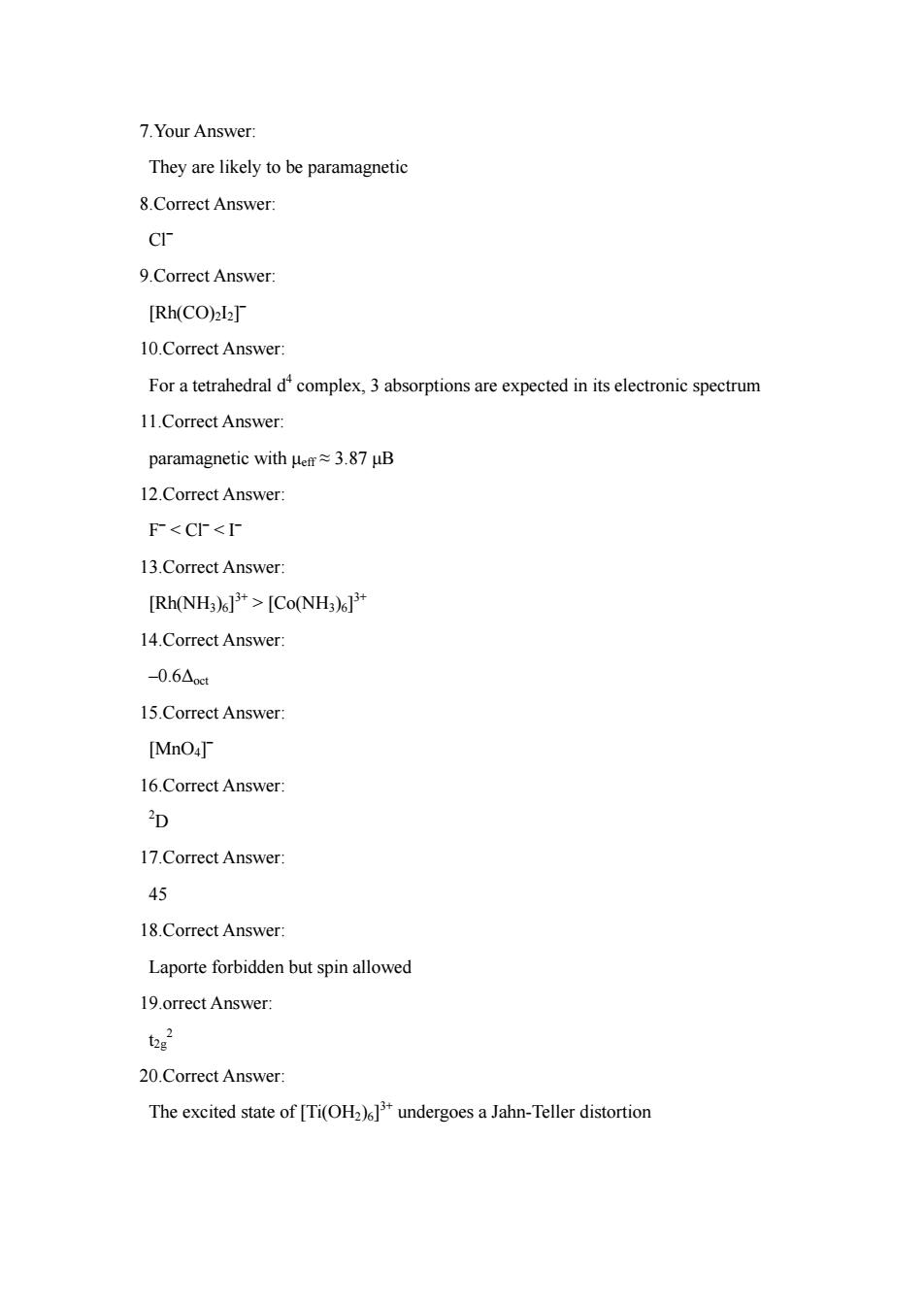
7.Your Answer: They are likely to be paramagnetic 8.Correct Answer 9.Correct Answer: [Rh(CO)2I2J 10.Correct Answer: For a tetrahedralcomplex,3 absorptions are expected in its electronic spectrum 11.Correct Answer: paramagnetic with e3.87 uB 12.Correct Answer: F[Co(NH3)6] 14.Correct Answer: -0.6△c 15.Correct Answer: [MnO 16.Correct Answer: 2D 17.CorrectAnswer: 45 18.Correct Answer: Laporte forbidden but spin allowed 19.orrect Answer 2e2 20.Correct Answer: The excited state of [Ti(OHundergoes a Jahn-Teller distortion
7.Your Answer: They are likely to be paramagnetic 8.Correct Answer: Cl– 9.Correct Answer: [Rh(CO)2I2] – 10.Correct Answer: For a tetrahedral d4 complex, 3 absorptions are expected in its electronic spectrum 11.Correct Answer: paramagnetic with μeff ≈ 3.87 μB 12.Correct Answer: F– [Co(NH3)6] 3+ 14.Correct Answer: –0.6Δoct 15.Correct Answer: [MnO4] – 16.Correct Answer: 2 D 17.Correct Answer: 45 18.Correct Answer: Laporte forbidden but spin allowed 19.orrect Answer: t2g 2 20.Correct Answer: The excited state of [Ti(OH2)6] 3+ undergoes a Jahn-Teller distortion 7